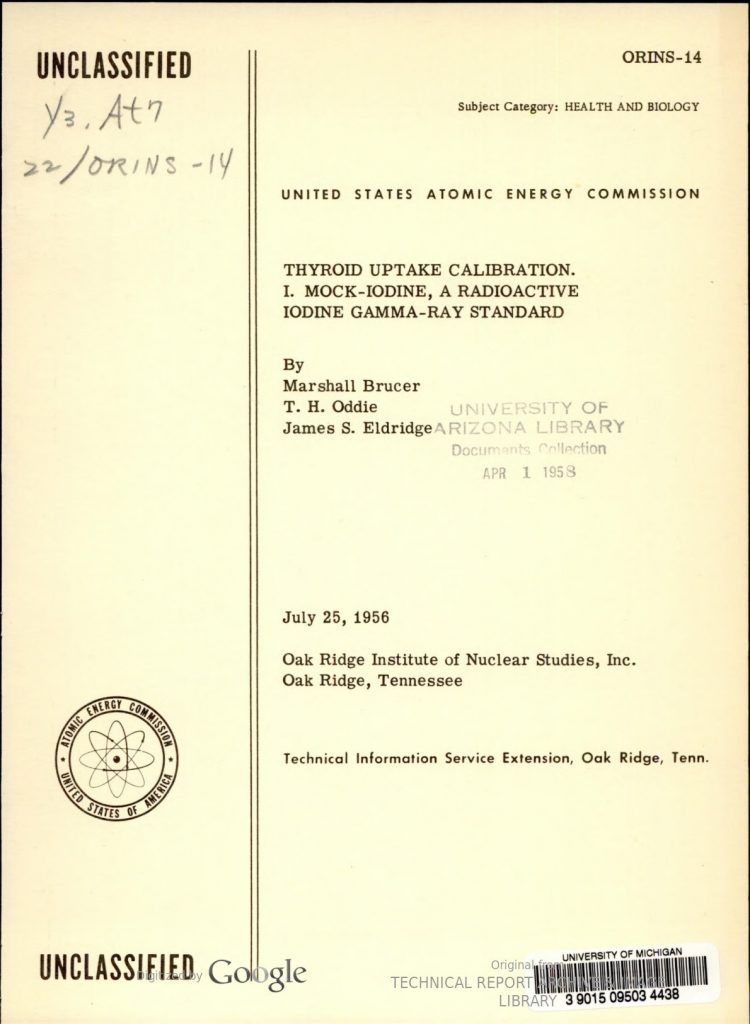
CWP Blog | CWP
The History of Oak Ridge Institute of Nuclear Studies (ORINS)
November 26, 2018
November 26, 2018
CWP
CWP Blog
By Susan Adkisson
The Oak Ridge Institute of Nuclear Studies (ORINS) Cancer Research Hospital’s was a 30-bed hospital and was completed in 1950, The first patients accepted by the division were those who had diseases for which there was already an established backlog of experience in the therapeutic use of radioisotopes. Nurses also worked there and I was told by one I know that “they put all waste from these patients into a large “vat”, which went underground the building into large tanks”.
ORINS was contracted to train scientific personnel in the use of radioisotopes and the primary students were graduate students. My father was one of these who had previously attended the University of Tennessee and he worked directly for the Medical Director, Marshall Brucer. Dr. Marshall H. Brucer was appointed Chairman of the Medical Division of ORINS and the first patient who was admitted to the hospital/research facility in May 1950. Early efforts at internal radioisotope therapy were largely unsuccessful. External radioisotope sources were being considered to be used in place of x-rays and to produce an external beam that could possibly treat cancer without placing a radioactive substance inside the body.
Cobalt-60 was considered a good candidate for external teletherapy. A machine was designed in 1951 and placed in a specially built room at ORINS. After being proven to be an efficient method for providing a radiation dose using Cobalt-60, the machine was sent to M.D. Anderson Hospital in Houston, Texas, for clinical trials. The trial proved so successful that Cobalt-60 became the most widely used teletherapy source.
Radioiodine-131 became available from the Oak Ridge National Laboratory and was used to diagnose and treat thyroid cancer. My father worked with radioactive iodine and performed studies on it at ORINS. One of the many papers he wrote is available online:
ORINS initiated a radioiodine uptake calibration program in 1954 and used mannequins to place artificial thyroid glands with accurately known levels of mock iodine in their necks. My father told us one of the mannequins was named “Bonnie” and brought us home pictures of him working with her. The calibration kits they used were sent to clinics where local instruments were used to measure the thyroid dose and uptake of mock iodine in the mannequin. The local instruments weren’t consistent in their readings and thus the treatment was inconsistent around the country. My father then went to work at ORNL in the Analytical Chemistry Division and stayed there until his death in 1990.
ORINS worked jointly with ORNL, and a new instrument was designed which quickly became commercially available. This technological advancement, initiated by ORINS, which featured the ability to concentrate on the gamma energy from radioiodine, made radioiodine thyroid diagnosis and treatment a standard and reliable medical procedure.
In 1960, when the new “Oak Ridge Hospital” was completed, the AEC community hospital was renovated and ORINS Medical Division patients moved into the old hospital. This would be the home to the Medical Division until the inpatient care hospital was closed in 1974. The Medical Division, from 1948 to 1974, resulted in many studies with regard to radiation and its effects on humans and animals. The people associated with that time in our history contributed greatly to our understanding human interaction with the Nuclear Age.
The primary reason for the closure of the clinical inpatient care facility was because other hospitals were, by the 1970’s, able to practice nuclear medicine. This came about because the AEC hospitals, including ORINS, were responsible for developing the whole new field of nuclear medicine. My father continued to study the effects of radiation and toxins on area animals and insects. For many years he worked the “Oak Ridge Reservation Deer Hunts” checking the white-tailed deer for radionuclide concentration, including strontium- 90, in the deer antlers before they were allowed to be released back to the hunter.

